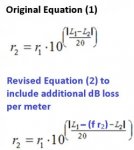Hi. I’m working on an equation to find Sound Pressure Level attenuation over distance. Equation 1 allows me to find the distance at which SPL drops to a desired SPL.
Finding Distance (r2), when -
Reference SPL (L1) is known
Reference Distance (r1) is known
Desired SPL (L2) is known
For instance, I know the SPL (L1) is 87dB at Distance (r1) of 1meter.
I need to find the Distance (r2), at which the SPL falls to the Desired SPL (L2) of 66dB.
Equation 1 allows me to find the answer, which is 11.19meters. This just follows the 6dB loss per doubling of distance rule.
However, I’m also trying to include an additional amount of dB loss per meter (let’s call it “f”).
Therefore, I have a formulated Equation number 2 to take into account the “f”dB loss per meter, aswell as the original 6dB loss per doubling of distance.
My problem is that I now have Distance (r2) on both sides of the equation. Can this be solved, to isolate “r2 “ by itself on one side of the equal sign ?
Any help would be very much appreciated. Many thanks, Martin
Finding Distance (r2), when -
Reference SPL (L1) is known
Reference Distance (r1) is known
Desired SPL (L2) is known
For instance, I know the SPL (L1) is 87dB at Distance (r1) of 1meter.
I need to find the Distance (r2), at which the SPL falls to the Desired SPL (L2) of 66dB.
Equation 1 allows me to find the answer, which is 11.19meters. This just follows the 6dB loss per doubling of distance rule.
However, I’m also trying to include an additional amount of dB loss per meter (let’s call it “f”).
Therefore, I have a formulated Equation number 2 to take into account the “f”dB loss per meter, aswell as the original 6dB loss per doubling of distance.
My problem is that I now have Distance (r2) on both sides of the equation. Can this be solved, to isolate “r2 “ by itself on one side of the equal sign ?
Any help would be very much appreciated. Many thanks, Martin

